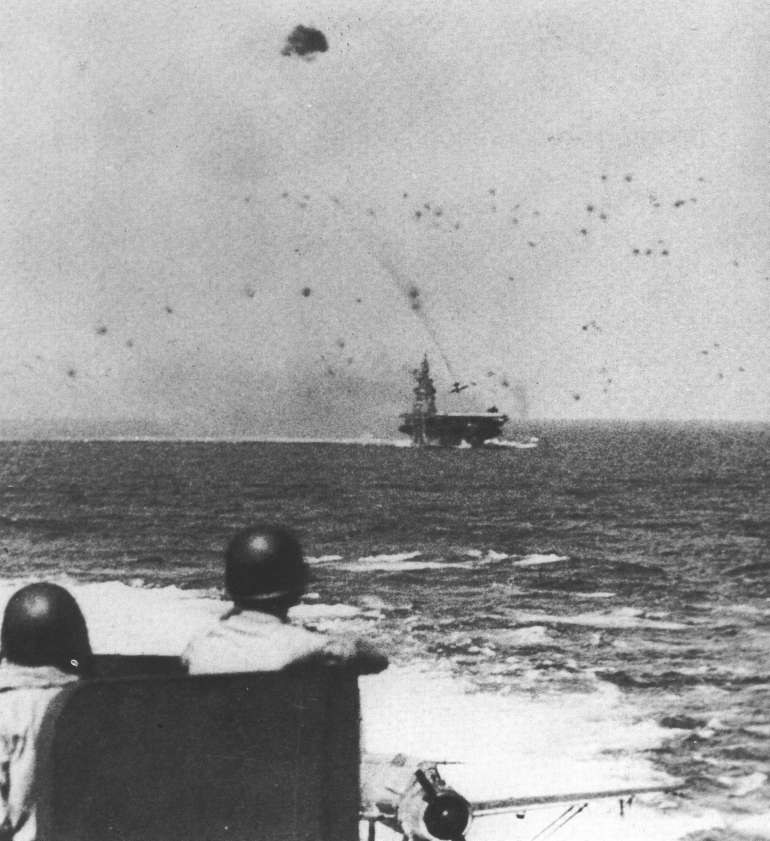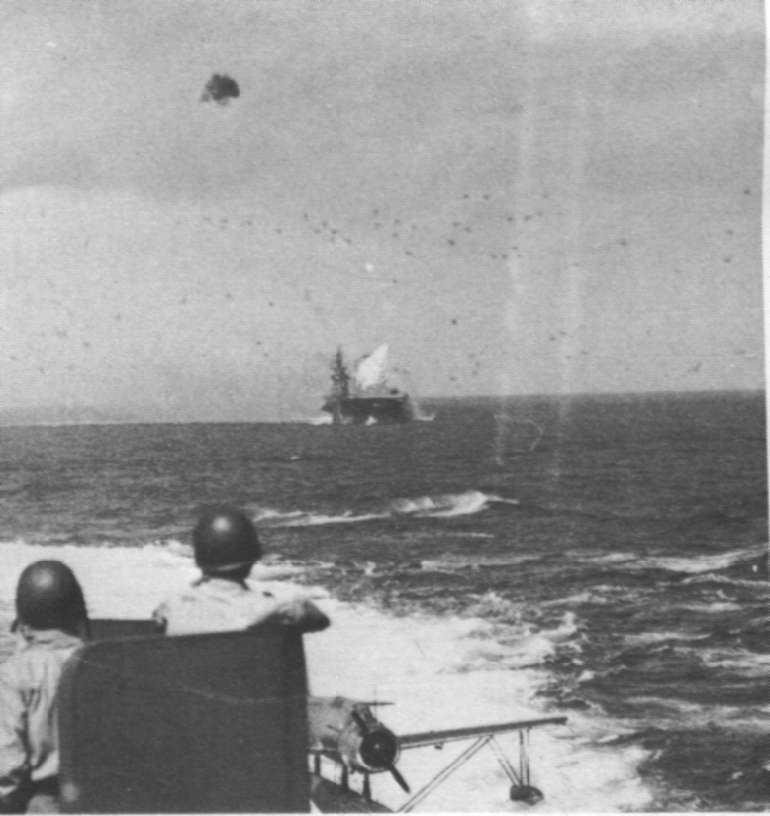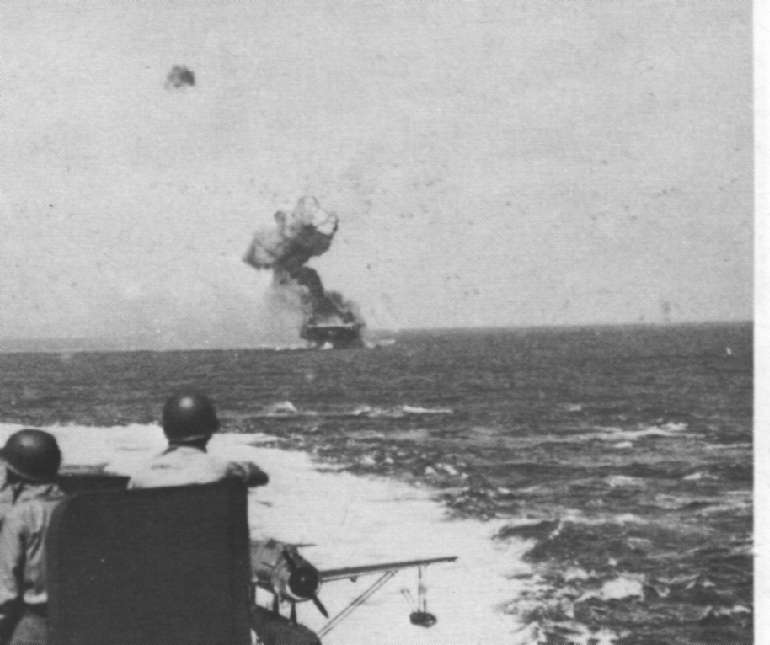|
Posted on 05/23/2003 5:37:11 AM PDT by SAMWolf
|
|
 are acknowledged, affirmed and commemorated.
|

| Our Mission: The FReeper Foxhole is dedicated to Veterans of our Nation's military forces and to others who are affected in their relationships with Veterans. We hope to provide an ongoing source of information about issues and problems that are specific to Veterans and resources that are available to Veterans and their families. In the FReeper Foxhole, Veterans or their family members should feel free to address their specific circumstances or whatever issues concern them in an atmosphere of peace, understanding, brotherhood and support.
|
|
|
|
Japanese Kamikazes In the 13th century, as legend goes, a Mongol emperor massed a large fleet for the invasion of Japan. The Japanese nation had little to defend itself with, and a Mongol conquest seemed certain. As the fleet massed outside Tokyo Bay gathered to attack, a typhoon came up and either sank all the ships or blew them back to China. This storm, which the Japanese believed was sent by the gods to save their nation, was called "Divine Wind." In Japanese, the name is "Kamikaze."  Vice Admiral Takajiro Ohnishi, Japanþs foremost expert on naval aviation and at one time Admiral Isoroko Yamamotoþs close advisor on the subject, formulated a plan wherein Japanese pilots would suicide-crash their planes into American ships. This tactic, which Ohnishi hoped would save Japan, was called kamikaze, in honor of the typhoon that saved his country from invasion. The formal name of the unit that had this mission was the Kamikaze Special Attack Corps. The kamikazes were unique in military history. Death in war is inevitable, but Japanese naval doctrine prior to 1944 forbid carrying out a mission unless there was some chance of survival. Adhering to the code of bushido (code of the warrior), all Japanese military men were prepared to die for the Emperor. This stemmed from the Japanese ideal of "The Path of Eternal Duty," the belief that family and individual welfare were not important when compared to the long history of the Empire. Japanese literature is replete with examples of warriors who died a glorious death on behalf of the Emperor. The kamikazes, however, were the first unit to actually seek death in battle. This concept was repugnant in the West, and there were those on the Japanese Imperial General Staff who objected to this strategy. They felt this step was needless, a waste of men, and an acknowledgement that Japan had lost the war. In spite of this opposition, Ohnishi lobbied strongly for his plan, and it was finally, if reluctantly, accepted.  The American invasion of Leyte (the Philippines) in October 1944 saw the debut of the kamikazes. The escort carriers guarding the transports and beaches had the dubious honor of being the first American naval units to encounter the Divine Wind. "Sacred warriors" sank the escort carrier St. Lo and damaged several other ships. Their efforts had little effect on the invasionþs outcome. The damage they inflicted, however, was a prelude to later and more effective massed attacks, particularly at Okinawa. The kamikazes continued attacks against American shipping through the remainder of the campaign in the Philippines. During the invasion of Iwo Jima, they continued the strategy of attacking shipping, both combatant and transport. Some escort carriers were sunk and some major fleet combatants, particularly the aircraft carrier Franklin, were severely damaged. However, Iwo Jima was taken and secured. The significant point about these two campaigns was that these kamikaze attacks were carried out independently of other Japanese defense measures. Okinawa was different.  At Okinawa, which was invaded by American troops on Easter Sunday, 1945, the kamikazes were incorporated from the beginning as an integral part of the defense of the island. Being the closest land to the Empire yet invaded, Japanese strategists were determined to hold the island at all costs. Kamikaze operations at Okinawa were the fiercest of the war, and the most frightening, in view of their intensity. The Okinawa kamikazes were called "kikusui," meaning "floating chrysanthemum," in honor of the imperial symbol of Japan. From the onset of the invasion until the end of the Okinawa campaign, over 1,900 suicide attacks took place. The largest number of attacks was carried out during the period April 6-7, when 355 planes participated. American strategy was revised to deal with the threat. An outer picket ring of radar-equipped ships, usually destroyers, destroyer escorts and minesweepers, was established to provide early warning of incoming kamikaze raids. It was hoped that with enough advance warning, fleet units would be able to disperse in time to repel the threat. These picket ships bore the greatest brunt of the kamikaze attacks. They were often kamikaze targets because from the air, the inexperienced Japanese flyers mistook them for battleships and cruisers.  One of these picket ships underwent an amazing ordeal in the waters off Okinawa on April 16, 1945. The destroyer Laffey, under the command of Commander (later Rear Admiral) F. Julian Becton, was assigned to radar picket station No. 1 that day. In a period of 80 minutes, Laffey underwent 22 separate attacks by 32 planes. She was struck by six of them, suffered four bomb hits and was continuously strafed. Her gunners destroyed at least eight of the attackers. At the conclusion of the attack, only four of Laffeyþs 20mm mounts were still firing. Her main batteries were destroyed, her stern was almost awash, her rudder was jammed, and she was barely able to make steam. Laffeyþs gallant crew, under the direction of Becton, who vowed that he would never abandon his ship while one of its guns still fired, made heroic efforts to save their stricken vessel. They not only kept Laffey afloat, but managed to bring her home to Seattle, Washington, under her own power for repairs. Laffey continued in service until well after World War II, when she was finally and honorably decommissioned. Were the kamikazes successful? From a strategic and tactical point of view, the answer is "no." Ohnishi hoped they would turn the tide of the war in Japanþs favor, and allow at least a negotiated peace. He had hoped that the Americans would psychologically be unable to deal with this type of threat. He was wrong on both counts.  The kamikazes operating during the Okinawa campaign did take a terrible toll on American lives and ships. At the beginning of the suicide operations, there was stunned disbelief on the part of American sailors that other men would be willing to kill themselves in order to destroy them. Because the threat was continuous, shipsþ personnel were forced to remain at battle stations for days on end. Fatigue began to take its toll, on ships and men. Sleep and food, often taken for granted, became precious to American sailors. In summation, the Okinawa kikusui operation damaged 368 ships and sunk 32. Suicide planes killed 4,900 American sailors and wounded over 4,800. These were the heaviest losses incurred in any naval campaign in World War II. Over 2,000 Japanese pilots lost their lives in the suicide attacks off Okinawa. Because the many kamikaze attacks at Okinawa did not stem the American advance, Vice Admiral Matome Ugaki, commander of the Japanese 5th Air Fleet, wanted to atone to the Emperor and the kamikazes who died under his command. He ordered three planes readied, intending to lead a final suicide attack against Okinawa. The attack was scheduled to leave Japanþs Kyushu Island on Aug. 15, 1945, the day the Emperor announced the decision to surrender.  When Ugaki went to his plane, 10 others were revved up on the runway with it. Questioning this, Ugaki was told by the squadron leader that when the fleet commander himself led the attack, every squadron plane would follow. True to the code of the warrior, the 11 took off for Okinawa. Symbolic of the futility of the kamikaze attacks in changing the warþs outcome, the mission did not succeed. The plane flown by Ugaki fell harmlessly into the Pacific Ocean. Late in the evening of Aug. 15, Ohnishi, the man who sowed the Divine Wind, committed hara kiri, the ritual suicide of the Japanese warrior.
|
Mark Litke
CHIRAN, Japan, Dec. 28 — It all took place more than a half-century ago, but the images have an eerie similarity to Sept. 11, 2001, as does the shock of those who witnessed the attacks.
"One-third of the men on the ship were lost," retired U.S. Navy Rear Adm. Robert H. Spiro Jr. recalled of one attack. "So, it was personally devastating. It was heartrending. At the same end, for a few hours we saw blood. The ship was on fire. We thought the bow was going to break off."
The similarities don't end with the images and emotions. Looking back at Japan's infamous kamikaze, they seem more related to the pilots of al Qaeda than most Japanese today would like to admit.
They were fanatically devoted to their emperor, who was considered a god at the time. They were motivated by self-righteous anger against the West.
"Many Japanese do believe that they fought a just war," said Gregory Clark, president of Tama University in Japan. "[They believe] that they were fighting under extreme odds. And that anything was justified in the attempt to win this war, in which they were clearly the weaker power. And that included using kamikaze."
‘No Other Way to Fight Back’
More than 5,000 kamikaze died before the end of the war, and 20,000 were still awaiting missions. But a handful who did take off on suicide missions are still alive today.
"We had no other way to fight back," said Kenichiro Onuki, a volunteer who crash-landed before reaching his target. "This was the only way to prevent the U.S. military from advancing into our homeland."
Another survivor, Kensuke Kunuki, said through a translator: "I had no fear. I wanted to sacrifice my life."
Kunuki suffered terrible burns when his plane was forced down by mechanical problems. He said his first thought at the time was that he wanted to try again because he hadn't killed any Americans.
‘They Were Not Fanatics’
In a new book on the kamikaze, Hideaki Kase, an outspoken Japanese nationalist, said there was no truth to the wartime propaganda that portrayed the kamikaze as a fanatical cult. He says they were no different than American youths who gave their lives in desperate military campaigns.
"They were not fanatics," Kase said. "They were not brainwashed. They were ordinary, young kids."
Even today, he says, the West has difficulty grasping the notion that suicide is a noble act in some cultures.
"Suicide can be honorable, positive, if that act was committed for the family or for the community or for the motherland," Kase said, adding that "patriotism — yes, patriotism" drove the kamikaze pilots.
Years Later, Heroic Depictions
Patriots? Immediately after the war, a demoralized Japan saw the kamikaze as symbols of military madness. The very word "kamikaze" became a synonym for crazy, reckless behavior.
Yet few Japanese could ignore the fact that the kamikaze spirit was deeply ingrained in the Japanese psyche — duty, loyalty, sacrifice for the good of the group. Half a century later, the kamikaze are no longer viewed in such black-and-white terms.
Rare color images of the suicide attacks from American archives are now included on popular videos in Japan. They are among a flood of retrospective books, documentaries and commercial films that portray the kamikaze more heroically.
Most of the kamikaze took off on their one-way missions from bases on Japan's southernmost island of Kyushu, and the largest base was in the town of Chiran.
Today, Chiran has become a testament to Japan's renewed fascination with the suicide pilots. It's now home to the country's largest kamikaze museum, which attracts nearly 1 million visitors a year. Many are moved to tears by the haunting faces of the boys about to die and the emotional poems and farewell letters they wrote.
"At the moment of death," a visitor remarked, "they must have been calling out for their mothers."
The museum has become a favorite of Japanese nationalists, who want Japan to stop apologizing for the war and to build a strong military again. For them, the kamikaze embodied Japan's samurai warrior spirit and should be idolized.
‘They Could Not Back Down’
That's exactly what Akihisa Torihama hopes will never happen. He is the grandson of Tore Torihama, a woman once called the kamikaze's "mama-san." She ran a small restaurant in Chiran where many of the pilots had their last meals and confided all the things they could not say in their heavily censored letters home.
"My grandmother told me the boys knew the war was lost, knew their lives were being thrown away by their commanders," he said through a translator. "They flew their missions because the social pressures on them were so great, they could not back down."
Today, he has transformed the old restaurant into an alternative kamikaze museum, to keep alive the message passed on by his grandmother — that the suicide pilots were not heroes, but the victims of fanaticism.
And what's the verdict of the surviving kamikaze? Kuniki says he has no regrets.
"My nation and my family were in danger," he said. "History will judge if we were right or wrong."
But Onuki said it was wrong to waste so many young lives.
"Yes, we volunteered, but we were ordered to volunteer," he said. "It could have taken real courage to disobey that order."
‘Not a Single Civilian’
The surviving kamikaze, like most Japanese, bristle at suggestions that the kamikaze were the same as the al Qaeda suicide pilots.
"They killed only military personnel," Kase said. "Not a single civilian."
That distinction is not lost on Spiro, who as an American sailor who faced the kamikaze in combat.
"At least it was a military tactic and they were not attacking our wives, children, friends, mothers," Spiro said.
Still, there's no question that recent events have cast Japan's suicide pilots and their motivations in a very new light.
I don't buy the comparison.
Purposely killing women and children civilains and reveling in it, is no way near like the Japanese Kamikazes. The motives where entirely different and the Japanese used it as a desparate military measure, not as a way to get "72 virgins to deflower" in some bullsh*t version of Heaven.
Bushidô is best understood as blind obedience to one's feudal Lord, a pervasive and dominant mode of thought which had never been codified. Rather, the most psychotic elements of Japanese warlord behavior were later drawn together and popularized in the late 19th century to assist in indoctrinating the new Imperial Japanese Army.
There's a thread coming up in the USS Indianapolis.g
Disclaimer: Opinions posted on Free Republic are those of the individual posters and do not necessarily represent the opinion of Free Republic or its management. All materials posted herein are protected by copyright law and the exemption for fair use of copyrighted works.